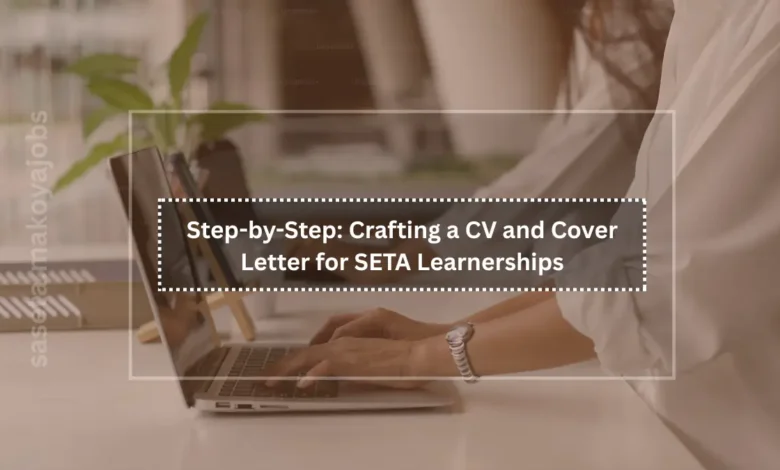Step-by-Step: Crafting a CV and Cover Letter for SETA Learnerships

Learn how to write a professional CV and Cover Letter for SETA Learnerships applications. This guide includes formatting tips. things to avoid
Crafting a SETA-Specific CV and Cover Letter
Applying for a SETA learnership demands more than a standard CV—it requires tailored documents that demonstrate readiness, professionalism, and relevance to the sector training opportunity. This guide walks you through writing a compelling CV and cover letter specific to SETA applications, offering structure, style, and substance aligned with AdSense policy.
1. Understanding SETA Application Expectations
SETA learnerships combine classroom learning with workplace training and require candidates to show:
- Commitment to the sector
- Attention to detail
- Compliance with instructions
- Professional communication
Your application documents—CV and cover letter—should reflect these traits through clarity, relevance, and a tailored approach.
2. The SETA-Specific CV: Structure and Style
A SETA-targeted CV should be concise (1–2 pages), easy to scan, and structured into clear sections:
Header & Contact Details
- Full name
- Professional email and phone number
- City and province (e.g. “Pretoria, Gauteng”)
- Optional: LinkedIn profile
Professional Summary or Objective
A 2–3 line statement explaining:
- Your career ambition
- Relevant background (e.g. “Recent Matric graduate enthusiastic about learning in the hospitality sector”)
- Motivation for choosing that SETA’s learnership
Education
List your most recent qualification at the top:
- Institution name, qualification title, NQF level
- Year completed
- Include notable performance like math or language scores
Skills & Competencies
Focus on:
- Soft skills: communication, teamwork, reliability
- Technical skills tied to the sector: basic IT, customer service, filing, hygiene, etc.
Work Experience or Volunteering
If you’ve worked or volunteered:
- Employer or organisation name and location
- Your role, dates, and key responsibilities
- Showcase transferable experience (e.g. cash handling, client assistance)
Optional: Extracurricular Activities
Highlight leadership, community service, sports, or school projects—especially those involving teamwork or responsibility.
Additional Information
- Drivers’ licence (if relevant)
- Nationality (SA citizen)
- Availability (full-time for 12–24 months)
3. The SETA Cover Letter: Format and Focus
A strong cover letter complements your CV and shows why you’re suited to that specific learnership:
Opening Paragraph
- State the learnership name and reference (if available)
- Explain how you learned about it
- Briefly express enthusiasm for the sector
Body Paragraphs
- Why you’re a good fit: reference your skills, education, and personal qualities
- Relevance to the sector: tie your motivation or background to that industry
- Your goals: describe how the learnership will support your aspirations
Closing Paragraph
- Politely express readiness for assessment or interview
- Thank the reader for considering your application
- State that certificates and documents are attached
Professional Sign‑Off
- Use a closing such as “Yours sincerely,”
- Include your full name and contact number
4. Tailoring Both Documents to the Specific SETA
Research and Personalize
- Mention the specific SETA (e.g. “I am very interested in the Cleaning Services learnership offered by Services SETA”)
- Include sector keywords: e.g. “facility hygiene,” “customer service,” “labour relations.”
Use Readership-Friendly Formatting
- Clean, legible font (Calibri or Arial, size 11–12)
- Use bullet points and short paragraphs
- Consistency in font and margins across both documents
Follow Submission Instructions
- Stick to required file formats, filenames, and subject lines
- Attachments must be correctly labeled (“Surname_CV.pdf”, “Surname_LEARNERSHIP_Letter.pdf”)
5. Common Mistakes to Avoid
| Mistake | Why It Hurts | How to Fix It |
|---|---|---|
| Overlong CV | Too much detail is overwhelming | Limit to 1–2 pages |
| Generic cover letter | Signals lack of interest in that SETA | Personalize per programme |
| Typos or formatting errors | Makes you seem careless | Proofread multiple times |
| Missing attachments | Leads to automatic disqualification | Double-check before submitting |
| Ignoring instructions | Shows lack of attention | Follow file name/subject prompts |
6. Getting Feedback and Making Improvements
- Peer review: ask a trusted friend or mentor to check both documents
- Career services: many organisations offer CV clinics or learnership advice
- Use clear feedback: refine phrasing, reorder sections, clarify gaps
7. Sample CV and Cover Letter Outline
Sample CV (Content Headings Only)
- Contact Information
- Professional Objective
- Education
- Skills & Competencies
- Work Experience / Volunteer Experience
- Additional Information
Sample Cover Letter (Structure Only)
- Opening (interest + how you heard about it)
- Two body paragraphs (qualifications + sector fit)
- Closing paragraph (thanks + readiness)
- Signature and name
8. How the Application Process Feels
- First submissions often bring rejections due to minor mistakes
- Better-quality documents often result in interview invites
- Being prepared with clean scans of ID, Matric, and CV helps move faster once shortlisted
Understanding the process from applicant to shortlist teaches discipline and attention to detail.
9. What Happens After Submitting
- You may be invited to attend an assessment or interview, either online or in person
- You might complete a literacy or numeracy test, or a short group task
- If successful, you’ll sign a learnership agreement and begin a training schedule
Your CV and cover letter remain critical—even beyond submission—as a record of professionalism.
10. Final Thoughts
Crafting a focused CV and cover letter for SETA learnerships is not just about filling spaces—it’s about presenting your best professional self. By tailoring your documents, following instructions, and polishing your presentation, you show respect for the programme, your ambition, and your readiness to learn.
Start early, personalize every application, and keep improving. Your efforts increase your confidence and your chance to secure a funded learnership—one that can launch a career with credibility and real skills.





